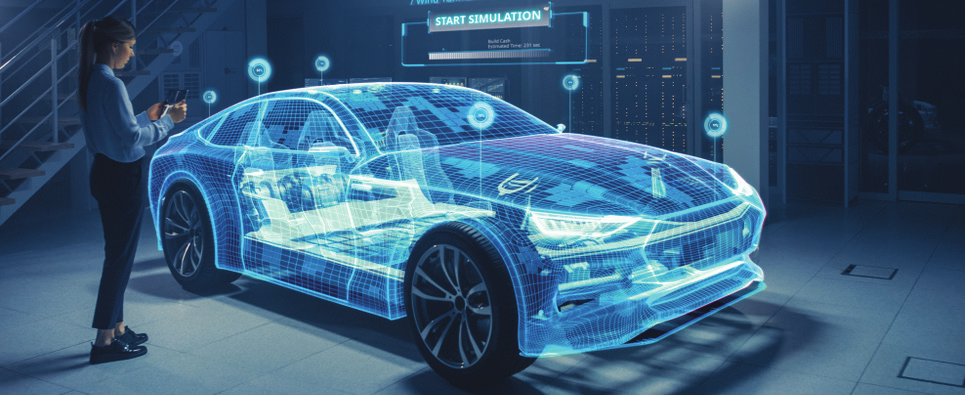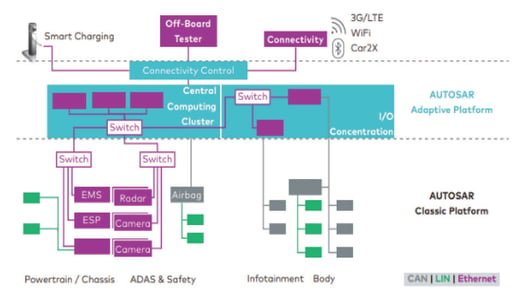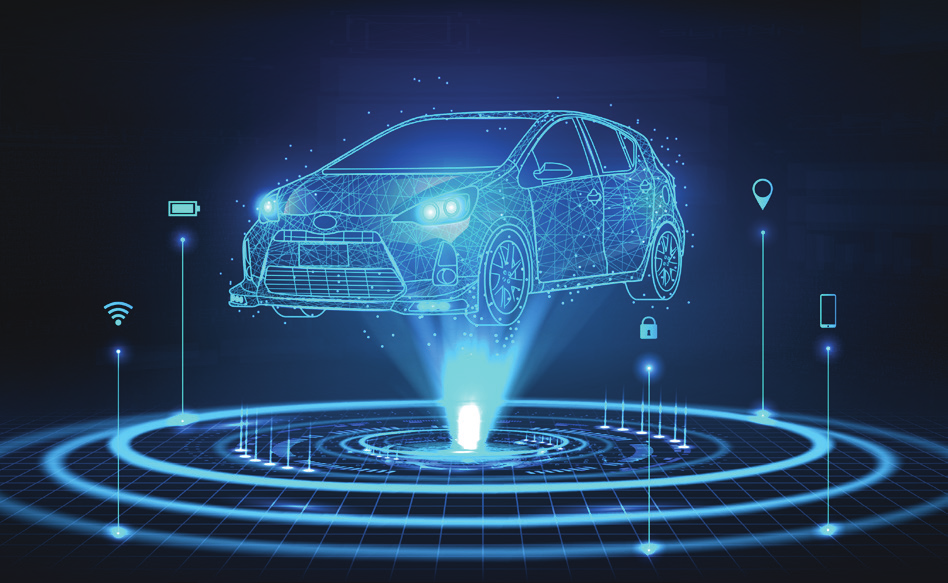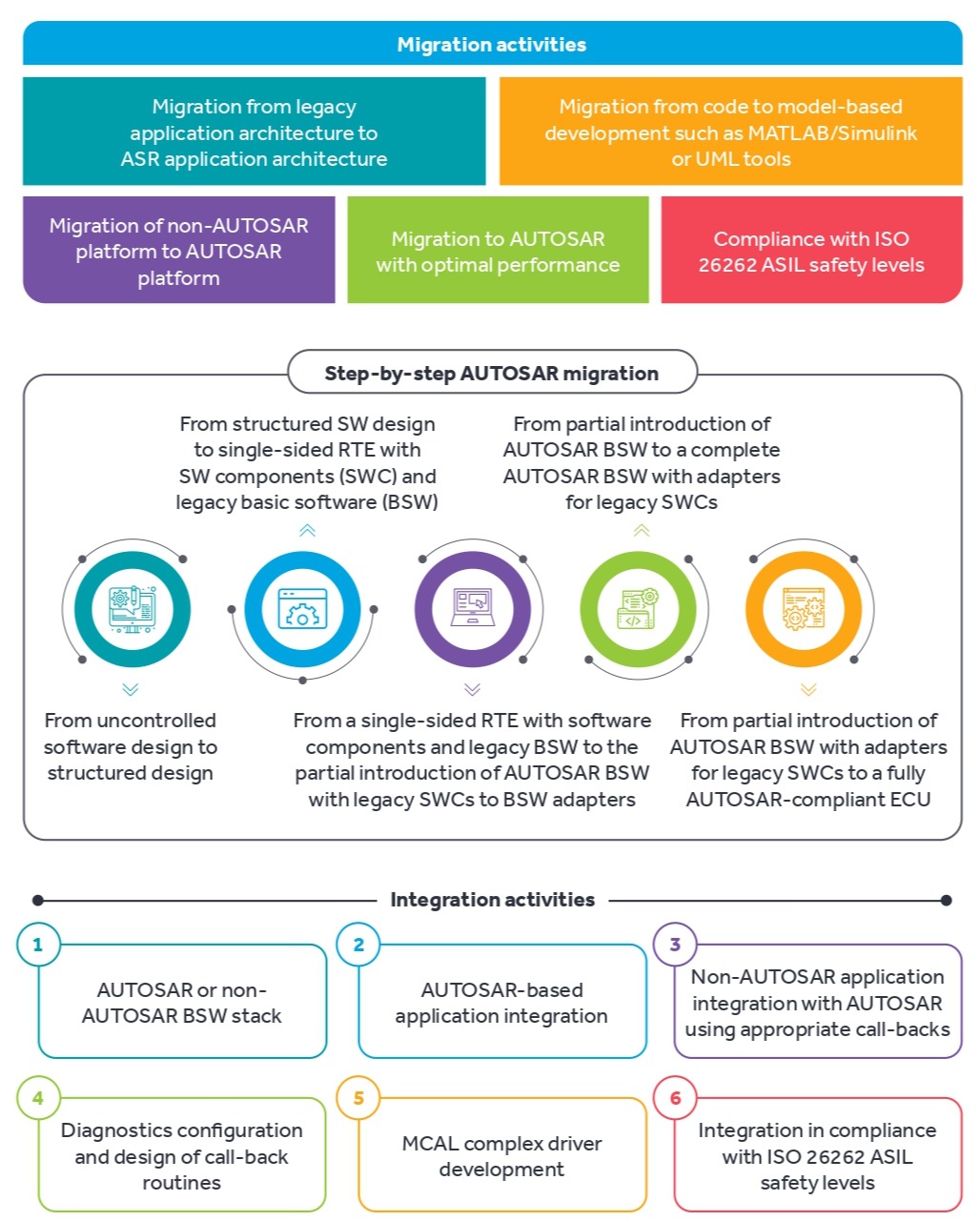
As automotive technology evolves rapidly in vehicle architecture to meet the growing demands of connected mobility and complex active safety goals, vehicle architecture needs to keep pace to handle growing volumes of data and support new and innovative applications. The latest AUTOSAR Adaptive platform is a step towards a mature standard framework for developing advanced driving assistance systems (ADAS) applications.
With vehicles becoming intelligently aware of their proximity to newer technology drivers, functional performance requirements of system-on-chip (SoC) processors have multiplied. However, the increased need for computing power calls for much more than multicore SoCs presently used by the AUTOSAR Classic Platform.
To accelerate with new innovations in the automotive market, the existing AUTOSAR Classic architecture is not feasible to support critical applications that use multi-sensors and usage of realtime data communication signals to take driving decisions. This has led to the development of a new platform, AUTOSAR Adaptive, to handle evolving high-performance requirements.
To achieve the robust performance requirements of modern Automotive Electrical/Electronics (EE) architecture, there are combined effects of processors and rapid communication accelerators. As a single chip is combined with processing elements, communication between the processing elements becomes orders of index faster and more efficient than legacy inter-ECU communications. This is furnished by high-performance computing and communication mechanisms from AUTOSAR Adaptive, which offers flexible configurations using Off-The-Shelf (OTS) Software.
AUTOSAR Adaptive aims to provide an environment with higher data rates/computing power, active deployment of new functionalities, interaction with non-AUTOSAR applications, support for OTA system updates and other services.

Innovations and trends are rapidly changing the automotive industry by defining new challenges and goals in an increasingly connected world. The need for new systems is spurring the development of new technologies to cater to these goals and the vast increase in software (SW) complexity and data exchanged between different applications.
Newer technology needs such as autonomous driving, Car-2-X applications, stronger interaction, and connectivity require an advanced platform that can support the features of intelligent vehicles. These requirements are significant drivers of 7% CAGR in the market for automotive SW and Electrical/ Electronics (EE) components, projected to grow to $469 billion from $238 billion between 2020 and 2030, per the McKinsey Center for Future Mobility Report.
In terms of accelerating new innovations in the automotive market, the current AUTOSAR Classic architecture may not be sufficient to support high-end applications that use multisensors for easy communication with the environment for driving decisions.
Latest automotive technologies, which offer real-time signal-based communication, are not feasible on the AUTOSAR Classic Platform, and need a new platform to handle these highperformance requirements.
The new AUTOSAR Adaptive Platform aims to provide an environment with higher computing power, higher data rates, active deployment of new functionalities, interaction with nonAUTOSAR applications, and support for OTA updates. The independent development of the AUTOSAR Adaptive Platform was aimed at having both platforms function together on the same network without risking the stability of the existing and proven AUTOSAR Classic architecture.

Courtesy: McKinsey Report
Highly automated driving: An enabler for L4 and L5 autonomous vehicles, where the vehicle driver will temporarily or partially transfer the responsibility of driving to the vehicle. This requires communication with traffic infrastructures like traffic signs and lights, cloud servers to access the latest traffic information or map data, and microprocessors/high-performance hardware for parallel processing for making decisions.
Car-2-X applications, Internet of Things (IoT), and cloud services require interaction with vehicles and off-board systems such as connecting to the Internet, secure onboard communication, support of cross-domain computing platforms, integration of nonAUTOSAR systems, and exchanging data with smartphones. Future cars will be connected to almost everything, such as smart homes, roadside infrastructure, and surrounding vehicles. This will help enable remote diagnostics, OTA updates, and easy repair and exchange handling.
Increasing data rates enables future autonomous and connected vehicles because the more the sensors, the more the data. It is said that connected cars generate ~25GB of data per hour and accumulate TB of data when combined with more selfdriving features.
New processor technologies to meet emerging high-performance requirements, as the current SoCs and SW systems available for self-driving vehicles may not be enough to handle autonomy on real roads. This would need new processor technologies that can address high-performance computing and are power-efficient and scalable.
AUTOSAR services and solutions, right from evaluation and assessment to migration strategy and actual implementation of standardized architectures, are becoming increasingly popular in modern automotive product development. OEM standardizations lean towards lowering costs and lead time through readily available well-tested modules. High-performance in-car computers are replacing the current domain controllerbased architecture for increased flexibility and distribution of functions. Great flexibility in the Adaptive platform implementation drives more computing power, which caters to next-gen vehicle architectures.
The AUTOSAR Adaptive platform is not intended to replace the Classic platform. However, the ECUs developed by both platforms will co-exist and communicate within the same vehicle network. AUTOSAR Classic is for deeply embedded ECUs based on microcontrollers, whereas the Adaptive contains the platform required for developing future automotive ECUs running on state-ofthe-art multicore SoCs. The interfaces allow customers to implement autonomous driving, OTA software updates, IoT features, media streaming, and other services in their future cars. Adaptive deployment and interaction with non-AUTOSAR systems through a common BUS interface ensures that the Adaptive will be treated as an extension of the AUTOSAR Classic Platform.

Source - Vector
The major change that AUTOSAR Adaptive brings to vehicle architecture is the use of Ethernet across the communication network. Adaptive ECUs will communicate over the Ethernet, while the Classic ECUs will continue to communicate over vehicle BUS networks such as CAN or LIN.
How will Classic and Adaptive ECUs communicate with each other? via a gateway ECU. The classic ECU acts as a gateway and packs the signals from the BUS system into a service that the Adaptive ECU can read. However, a conversion of the configuration format is necessary in this scenario.
In scenarios where the Classic ECU is purely signal-based and cannot pack the signal into a service, it converts the signals into UDP frames and transmits them over the Ethernet. The adaptive ECU is equipped with a “signalto-service” mapping feature to convert UDP frames to a service.
Further updates of today’s driver assistance/ safety systems, such as Adaptive Cruise Control (ACC), Automatic Emergency Braking (AEB), Blind Spot Detection (BSD), Auto Park Assist (APA), Lane Departure Warning (LDW) system, etc., pave the way for highly automated driving and autonomous parking. Future cars will be connected to almost everything, such as smart homes, roadside units, and vehicles around them, and thus will become a part of the Internet of Things. The Adaptive platform offers a secure platform that helps enable future automotive needs and achieve new functionalities. Therefore, a combination of AUTOSAR Classic and Adaptive will drive the automotive software infrastructure for safe and secure high-performance applications.


While the advantages of AUTOSAR Adaptive ECUs are well-known — high computing power, dynamic application deployment, compatibility between applications — it entails various challenges. Also, being a newly emerging standard in its initial stages, not all challenges may have immediate solutions. But the evolving process will finally result in exhaustive usage of the new standard in highend applications using powerful SoCs. Here are some typical challenges faced in AUTOSAR Adaptive implementation:
AUTOSAR Adaptive does not guarantee backward compatibility with the previous version. Upgrading to a newer version requires enormous effort and time. If a feature in the latest version is required to be supported, it needs customized development
There are certain dependencies with specific POSIX-compliant operating systems. Migration efforts are on to support multiple OS platforms. A design approach must be devised to develop an OS abstraction layer catering to widely used operating systems such as QNX, VxWorks, Integrity, etc.
Migrating a non-SOA application into AUTOSAR Adaptive architecture is complex. The existing applications need to be converted into services, checked if required by other ECUs and that these services are not redundant, and then host the Service catalog. The migration/integration of the existing C-based application or components into the Adaptive Platform will require tremendous time and effort as AUTOSAR Adaptive is based on C++
Specifications for AUTOSAR Adaptive foundation, services/ system tests are still in the concept phase and evolving
Evaluation of OSS and devising a strategy to ensure that the OSS does not impact the system where it is being used. This poses a significant problem when in safety-critical systems
AUTOSAR Adaptive has enabled the introduction of an open, standardized software architecture in the automotive industry. A highly versatile platform, it improves the performance and reusability of application software.
By simplifying the exchange and update options for software and hardware with the service-oriented architecture-based AUTOSAR Adaptive approach, it forms the basis for reliably controlling the growing complexity, improving performance, boosting faster communication, and enabling continuous updates of the electrical and electronic systems in motor vehicles.
AUTOSAR Adaptive’s high degree of multicore ECU communication, reuse, and exchangeability between suppliers’ solutions has greatly improved cost efficiency without compromising quality with an approach of develop-once-use-anywhere. As the maturity of the products increases with increased reuse, AUTOSAR Adaptive eases both the ECU and system integration and helps avoid typical pitfalls during integration resulting in a reduced development cycle.
Cyient (Estd: 1991, NSE: CYIENT)delivers Intelligent Engineering solutions for Digital, Autonomous and Sustainable Future
© Cyient 2024. All Rights Reserved.